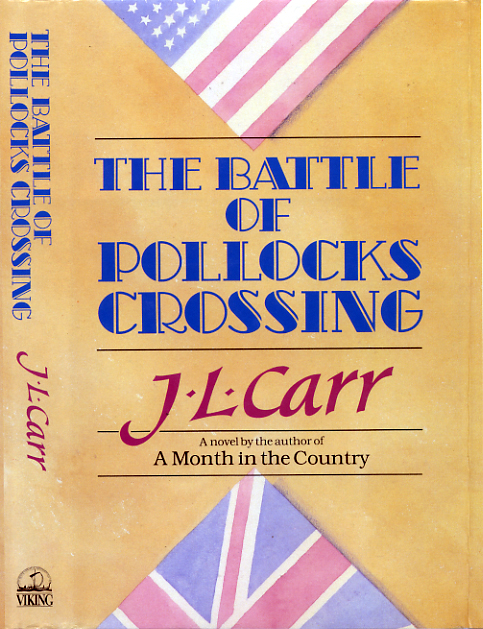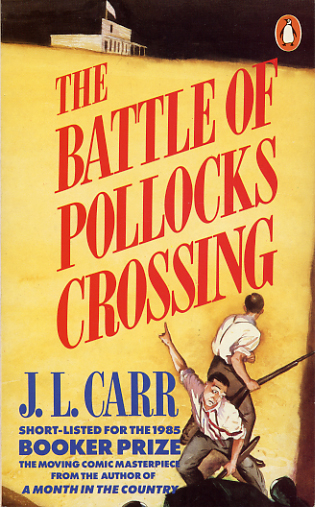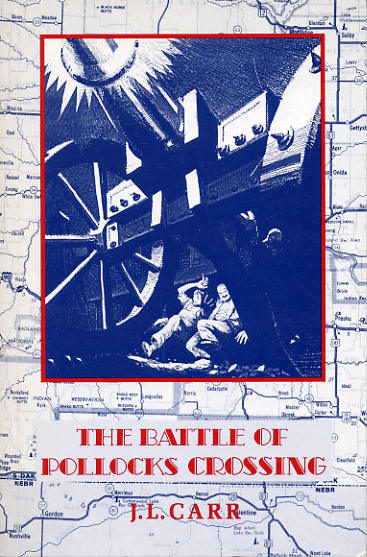The Battle of Pollocks Crossing
This is Carr's sixth novel. Carr drew on his experience of travelling to South Dakota in 1938 to teach in a High School in Huron, a small town on the prairie, and his experience of living there for 9 months on a British teacher's salary. He returned to the same school to teach again in 1956-57 during which he wrote The Old Timers, a social history of the life of the early settlers. In 1973 he drew and had printed a map of Beadle County.
According to Byron Roger's biography of Carr this was the first novel that Carr wrote, but obviously not the first that he published. The novel was was shortlisted for the Booker Prize in 1985.
On Monday 10th October 1938, The Evening Huronite newspaper reported the content of a letter received by J.L. Carr about the war crisis in England from a friend of his named Neil Pollock, a 22-year old clerk in a London steel tubing works: 'Things look terrible' Englishman says in letter to fellow countryman in Huron, was the title of the article. There is no apostrophe in name of this novel, but given that Carr took names of places from people and places that he knew, perhaps Neil was the inspiration for the title?
WorldCat lists a Braille edition of the title, published by Viking in 1985. This has not been seen (or touched).
● First edition
Publisher: Viking
Date of publication: 1985
ISBN: 0-670-80559-9
Size: 222 x 142 mm.
Pagination: 176 pp
Binding: Dark blue cloth; title and author in silver along spine with publisher to base
Dust jacket design: Stephen Raw
Price: £8.95. Some copies have been price-clipped and a Viking sticker with the price of £9.95 has been added, or the sticker covers the original price.
Copies sold: about 8,000 (Keith Wheatley, The Sunday Times, 28th February 1988)
Printed by: Hazel Watson & Viney, Aylesbury, Buckinghamshire
Dedication: For C.M. in his basement, R.I.P.
Front fold-in: It is 1929 and young George Gidner is desperate to exchange the toils of teaching in Bradford for a job in the land of his heroes: the Wild West of America. So it is that he buys a third-class ticket and sets off on a journey from Liverpool that will eventually bring him to Palisades, South Dakota, and to the banks of the Bitter-root River where, in the cool of the evening, he will stroll down along the wharves and warehouses to watch river-steamers breasting the current en route for Huron, Shenandoah and the head-waters of the Yellowstone River.

Front panel and spine of dust jacket
Or so George thinks. The reality proves rather different. For Palisades consists of six street bisected by six avenues, overhung with a blank sky, and - most alarming of all - a scarcely suppressed air of violence. The pupils at the high school where George has come to spend his year provide challenges in plenty. But these prove to be merely a test-run for the greatest challenge of all: the Battle of Pollocks Crossing. Years later, as an old man in Bradford, George would remember the day of the shoot-out with a shudder, the day when heroes died and something died in George's heart too.
J.L. Carr's first novel since A Month in the Country characteristically interweaves low comedy with high seriousness in a way that is probably unique in the English novel today. It has many sombre things to say, yet it's written with a gusto and verve that will delight its readers.
Rear fold-in: J.L. Carr was born and brought up in North Riding villages and now runs a small business in Northamptonshire.
Notes: Carr also published a small companion volume to coincide with the publication of this novel, Gidner's Brief Lives of the Frontier, a 16-page dictionary of some of the men and women who lived between 1810 and 1890 between the Mississippi and the Mountains.
The book is dedicated to Charles Moore, a brakeman and local historian in Huron, who is mentioned in the letter cited in the entry on Old Timers and in the Quince Tree Press edition.
According to WorldCat there are copies in more than 200 libraries around the world.
Inscriptions:
Carr wrote this inside a copy of the novel sent to a friend in Ireland in 1987:
This novel began life in 1960 as To the West, to the West. During the next 25 years it was re-written six or seven times, shedding one skin and taking on another. Even after Penguin Viking had accepted it for publication I took it off to a small hotel in the Lincolnshire Wolds and did further surgery.
It was a difficult story to pull into shape because of its foreign setting and foreign characters. I mean difficult to make it sound authentic. So I stacked as many cards as I dared in my favour – an Anglophile banker whose conversational style was influenced by 18th Cy English writers, pushing it back to 1930 when Americans might have behaved differently, using chunks of reminiscence of a visit to England, telling the story as a foreigner might, in his inexperience have interpreted it. Well novel-writing is artifice.
The physical background was easier. In 1938 I went to teach for a year at Huron, S. Dakota, High School and often went about 20 miles to Pearly Creek, a scatter of farms.
It has its weaknesses. I haven’t made it clear enough that Henry Farewell had never visited England and perhaps I shd have given the message to my young countryman in a louder voice.
Carr wrote this inside a copy of the novel that he gave to a friend in Kettering:
Tony, when one’s imaginative impulse is atrophied and yet one still need to fill in time by writing long stories, one assembles one’s resources, meagre though they are. Mine were these. In 1938/39 I taught for one year in a Dakota high school, lived sparely on a tight budget in a rooming house bed-sitter, fell in love in the train getting there, was too poor to travel further afield, wrote the locality’s early (1880) history for it onto a duplicator stencils and, since I couldn’t study America, studied Americans.
And I came to the conclusion that, although we spoke the same language, they were a very foreign race with an inclination towards violence. In 1985 I felt that, in some small way, I should remind my fellow countrymen of this. Hence for both reasons, The Battle of Pollocks Crossing was written and here given to you as my recognition of yr own defence of the rights of an individual. James Lloyd Carr April 15 1986
● Second edition
Publisher: Penguin Books, London
Date of publication: 1986
ISBN: 0-14-007798-7
Size: 180 x 111 mm
Pagination: 176 pp
Binding: wrappers
Cover illustration: Mark Entwistle
Price: UK £1.95, New Zealand $7.95, Australia $5.95, Canada $4.95
Printed by: Hazel Watson & Viney Limited, Aylesbury, Bucks
Dedication: For C.M. in his basement, R.I.P.
Notes:
Inscription: Carr wrote in a copy of this book in November 1987:
In 1938/39 I taught a year in Dakota. This is the background. The message is that we should be as wary of the Americans as we are of the Russians.

Front cover
● Third edition
Publisher: The Quince Tree Press, 27 Mill Dale Road, Kettering
Date of publication: February 1993
ISBN: 0 900847 96 4
Size: 197 x 131 mm
Pagination: 176 pp. The pages are numbered from 10 to 175, but there are only 3 leaves of 6 pages before pages 9 and 10. There is one leaf of two pages missing from the un-numbered preliminary pages, so the book is actually 174 pages in total.
Binding: card wrappers
Cover design: Christopher Fiddes
Price: UK £4.95
Printed by: Stanley L. Hunt (Printers) Ltd, Rushden, Northamptonshire
Copies printed: 2,000
Dedication: For Nelson Miner, George Bell, Jack Keller and Christie. And for my long-gone friend, Leila Baker, who was a pupil-teacher in Northfield, Minnesota, when the James brother rode on their last raid. Also for Isaac Crow, then 87, who I knew only for a few hours, but who, as a small boy in Springfield, saw Abraham Lincoln in his coffin. Nor can I forget Charlie Moore, brakeman, in his basement.
Charlie Moore is mentioned in the entry on The Old Timers.

Front cover
Notes: Carr stated on the title page that this was the fourth book published by the Quince Tree Press, but he also wrote the same inside the edition of Steeple Sinderby. They were both published in February, 1993 in small editions of only 2,000 copies. These were the last novels that Carr republished before his death in February 1994 so, unlike the two novels that he published himself, signed copies are uncommon.
More information about later impressions and foreign language editions can be found on the Wikipedia page for this novel (which I update).